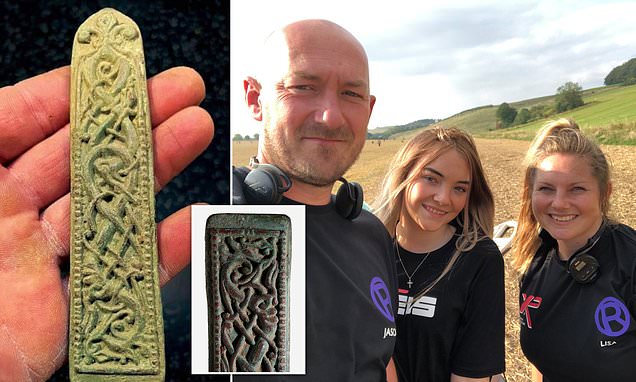Metal detectorist unearths 1,000-year-old Viking relic from a field in Norfolk and it could fetch up to £24,000 at auction
- Jason Jones, 44, uncovered a 5.5 inch long stone die two inches under the soil
- It was would have been pressed against an iron helmet to impart a pattern on it
- The die is being put up for sale at London-based auctioneers Noonans on 18 July
A metal detectorist who discovered a 1,000-year-old Viking relic has been told it could fetch up to £24,000 at auction.
Jason Jones, 44, was searching a field in Norfolk when he uncovered a 5.5 inch long stone die just two inches under the soil.
The construction worker had no idea what the 1.5 inch wide object was at first but after posting his find to Facebook he was flooded with messages from people helping him to identify it.
He learnt that the die, which is being put up for sale on 18 July, would have been pressed against the gold or silver cheek plates of an 11th century Viking iron helmet to impart a decorative pattern on it.
It has the pattern of the ‘world tree’ Yggdrasil and a serpent Nidhogg intertwining within its roots. In Viking or Norse mythology the Yggdrasill is an enormous ash tree that connects the nine worlds while serpents represented order and destruction.
Jason Jones, 44, discovered a 1,000-year-old Viking relic (pictured) and has been told it could fetch up to £24,000 at auction
The construction worker (pictured with his daughter Ela and wife Lisa) had no idea what the 1.5 inch wide object was at first
Jason had been detecting with his wife Lisa in a field where they had previously found two Medieval silver coins.
He said he had no idea what he uncovered until he posted a picture of it on Facebook and was told of its significance by other detectorists and archaeologists.
The construction worker, who also detects with his children, Rio, 19, Ela and Lia, said: ‘On January 29th of this year, my wife Lisa and I were searching on a field in Norfolk which had produced two Medieval silver coins on a previous visit.
‘I had forgotten to charge my main detector, so had to use my backup machine on this occasion.
‘I returned to the area where the coins were found and got a loud signal, and at a depth of just two inches found an unusual bronze object.
‘Lisa came over and was speechless when she saw it.
‘Neither of us had any idea what it could be, but that evening after posting a picture on Facebook we realised it was Viking in date and notified the local archaeologist to have it recorded.
‘It was soon to be clear it was a very interesting find due to the rapid response from the experienced detectorists and archaeologists on the groups.
‘My inbox went crazy with compliments and people trying to help identify the find.
‘Straight away, people from Scandinavia suggested it being a Viking piece of the Urnes Style.
‘I was advised to contact the British Museum to report and record.
‘The whole recording process was very interesting and a great experience.’
The die, which has the pattern of the ‘world tree’ Yggdrasil and a serpent Nidhogg intertwining within its roots, would have been pressed against the gold or silver cheek plates of an iron helmet to mark them
Jason (left), Lisa (centre) and Ela (right) at work detecting in a field
Jason Jones (second from the right) with wife Lisa (front) out on a detecting trip
Jason said he will split the proceeds from the sale with the landowner and spend his share on his family.
The intricate Urnes style ornamentation is going under the hammer at London-based auctioneers Noonans.
The Vikings invaded Britain in the 8th century when they landed on the island of Lindasfarne off the coast of Northumbria.
Harold II defeated the Viking invasion of King Hadrada of Norway at Stamford Bridge, York, in 1066 before being defeated by William of Normandy just three weeks later.
Nigel Mills, coins and artefacts specialist at Noonans, said: ‘This is an intricate 11th century Urnes style ornamentation possibly representing the world tree Yggdrasil with the monstrous serpent Nidhogg intertwining within its roots.
‘At the bottom is a fleur-de-lis which appears to form the tail of the serpent.
‘The die is used to replicate the design into a thin sheet of metal which is pressed into the die and then has the intricate design formed.
‘This is called repoussé and creates a lightweight decorative motif which can be applied to a military helmet.
‘In this case it is likely to be the cheek guards or the nose guard.
‘The helmet would be iron, and the decorative repoussé plaque would be either copper or silver or gold depending on the status of the recipient, and then applied to the helmet.
‘You can see this decoration on important helmets like the Sutton Hoo helmet.
‘It was identified as Viking on Facebook from the style which is typically Viking.
‘The precise identification came later when the museum at Norwich examined it.’
Source: Read Full Article





